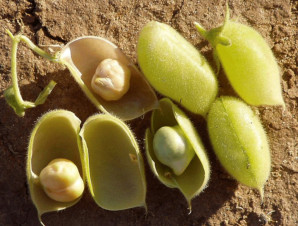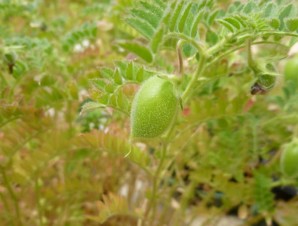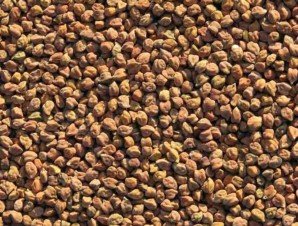Kala Chana – Garbanzo Bean
Kala Chana is an Indian name for garbanzo beans, or chickpeas -- also known as Bengal gram in India.
More Information
Kala Chana is a heirloom variety Garbanzo/Check Pea that is excellent for home gardens! Growing in almost any hardiness zone you have at least 80-100 days of heat and sunshine. (In cooler areas start beans indoors a few weeks early).
Planting time. The chickpea is a cool-season annual that requires 100 or so days to reach harvest. Chickpeas are frost tolerant but grow best where daytime temperatures range between 70 and 80º and where night time temperatures do not dip below 65ºF. Sow chickpeas in the garden as early as 2 ro 3 weeks before the average last frost in spring. Chickpeas require a long growing season; to get a head start on the season, sow chickpeas indoors in a peat or paper pot and transplant the pot and plant whole to the garden when the plants are 3 to 4 inches tall.
Planting and spacing. Sow chickpeas 1½ to 2 inches deep, spaced 3 to 6 inches apart. Space rows 18 to 24 inches apart. Do not soak seed before sowing and avoid heavy watering after sowing to keep seeds from cracking. Chickpeas allowed to grow a bit crowded will offer each other support.
Water and feeding. Keep planting beds evenly moist until chickpeas have pushed through the soil. Water regularly during flowering and pod formation. Avoid overhead watering which can cause flowers and pods to fall off. Mulch when the weather warms to conserve soil moisture. Add aged compost to planting beds in advance of planting. Side dress chickpeas with aged compost at mid-season. Avoid adding nitrogen-rich fertilizers to planting beds. Chickpeas, like other legumes, set up a mutual exchange with soil microorganisms called nitrogen-fixing bacteria to produce nitrogen compounds used by the plant.
Companion plants. Potatoes, cucumbers, corn, strawberries, celery, summer savory. Do not plant chickpeas with garlic.
Care. Avoid handling chickpeas when they are wet or covered with heavy dew; this may spread fungus spores. Keep planting beds weed free but cultivate around chickpeas carefully so as not to disturb the plant’s shallow root system. Rotate chickpeas and other legumes to add nitrogen to the soil.
Container growing. Chickpeas can be grown in containers 8 inches deep, the space required for a usable crop makes chickpeas a poor choice for container growing.
Harvest. Chickpeas will be ready for harvest about 100 days after planting. Chickpeas for fresh eating can be picked when pods are still immature and green; they can be eaten like snap beans. For dried chickpeas, harvest the entire plant when the leaves have withered and turned brown; place the plant on a flat, warm surface and allow the pods to dry. Collect the seed as the pods split. Seeds that will barely dent when bitten are sufficiently dry.
Storing and preserving. Unshelled chickpeas will keep in the refrigerator for up to one week. Dried, shelled chickpeas will keep in a cool, dry place for up to a year. Chickpeas can be frozen, canned, or sprouted.
Your package will include approximately 35+ Heirloom/Organic seeds.






